Companion Planting Herbs That Thrive Together
Can a well-planned herb garden unlock a world of flavors and scents? By choosing the right companion planting herbs, gardeners can make a garden that grows well together. This leads to healthier plants and more food.
Companion planting means growing different plants together to help them grow better. In an herb garden, this makes the garden stronger and more varied.
Exploring companion planting can help gardeners find the best herbs to plant together. This way, they can make a garden that is both beautiful and productive.
Key Takeaways
- Discover the benefits of companion planting for herb gardens
- Learn how to create a harmonious and thriving herb garden
- Explore the best herb planting combinations for optimal growth
- Understand the principles of companion planting and its applications
- Find out how to maximize yields and flavors in your herb garden
The Science Behind Herb Companion Planting
Learning about herb companion planting can change how we garden. It’s not just about putting herbs together. It’s about making a team that helps each plant grow better.
Understanding Plant Synergies and Allelopathy
Plant synergies happen when different herbs grow together. They can make each other grow stronger, taste better, or fight off pests. Allelopathy is when one plant sends out chemicals that can help or hurt nearby plants. For example, some herbs keep pests away, while others make the soil better for other plants.
Benefits of Strategic Herb Pairing
Pairing herbs wisely can bring many benefits. Here are a few:
- Pest Control: Some herbs keep pests away from other plants.
- Improved Soil Health: Certain herbs bring up nutrients from deep in the soil, helping nearby plants.
- Enhanced Growth: Companion herbs can provide shade, support, or release substances that help plants grow.
How Companion Planting Improves Garden Health
Companion planting makes gardens healthier by creating a balanced ecosystem. By picking the right herb pairs, gardeners can cut down on pesticides, improve soil, and increase plant variety. This way of gardening not only helps plants grow well but also makes gardening more sustainable.
By using herb companion planting, gardeners can grow strong, self-sufficient gardens. This method doesn’t just help plants. It also makes gardening more enjoyable.
What Herbs Can Be Planted Together: Basic Principles
To make your herb garden lively and strong, pick herbs that go well together. They should need similar things to grow. This is key to a healthy and fruitful herb garden.
Matching Growth Requirements (Soil, Sun, Water)
Herbs that like the same things grow better together. For example, rosemary, thyme, and oregano love dry soil and lots of sun. They’re great friends in your garden. On the other hand, mint and parsley need more water and some shade. Planting them together makes caring for your garden easier.

Considering Root Depth and Growth Habits
It’s important to know how deep herbs’ roots go and how they grow. Mint has aggressive roots that can take over. Planting it with other strong growers keeps things balanced. But, herbs with shallow roots or small growth can live peacefully with bigger ones.
Balancing Strong and Gentle Aromatics
Herbs’ smells can also affect who they grow well with. Basil and rosemary have strong scents that can either help or hurt each other. Mixing strong and mild smells makes your garden more pleasant and can even help plants grow better by keeping pests away.
| Herb Combination | Growth Requirements | Benefits |
|---|---|---|
| Rosemary, Thyme, Oregano | Well-drained soil, full sun | Drought tolerance, pest resistance |
| Basil, Parsley, Cilantro | Moist soil, partial shade | Enhanced flavor, improved growth |
| Mint, Chamomile | Moist soil, partial shade | Pest control, soothing ambiance |
By following these simple rules, you can make a beautiful and productive herb garden.
Mediterranean Herb Companions: Rosemary, Thyme, and Sage
Creating a harmonious herb garden with rosemary, thyme, and sage is not only aesthetically pleasing but also beneficial for their growth. These Mediterranean herbs are known for their drought tolerance and preference for well-drained soil and full sun. This makes them ideal companions in a garden.
Why These Drought-Tolerant Herbs Thrive Together
Rosemary, thyme, and sage thrive together due to their similar growing conditions. They are all drought-tolerant, which means they can survive with minimal watering. This makes them perfect for water-conscious gardening. As companion planting herbs, they not only coexist but also enhance each other’s growth by repelling pests and creating a beneficial microclimate.
“The synergy between rosemary, thyme, and sage is a testament to the power of companion planting,” says a renowned horticulturist. “These herbs complement each other in terms of growth habits and pest resistance. They create a resilient herb garden.”
Adding Lavender and Oregano to the Mix
In addition to rosemary, thyme, and sage, incorporating lavender and oregano can further enhance the diversity and resilience of your herb garden. Lavender’s calming fragrance and oregano’s pungency can complement the aromatic profiles of the existing herbs. This creates a rich and varied sensory experience.
When planting these herbs together, consider their herb garden layout ideas. Planting them in a way that allows for good air circulation can help prevent diseases and promote healthy growth.
Planting and Spacing Tips for Mediterranean Herbs
To ensure the best growth for your Mediterranean herbs, follow these planting and spacing tips:
- Plant rosemary, thyme, and sage with enough space to accommodate their mature size, typically 12-18 inches apart.
- Lavender and oregano can be planted closer together, around 6-12 inches apart, depending on the variety.
- Ensure the soil is well-drained and the area receives full sun for at least 6 hours a day.
By following these guidelines and choosing the best herbs to plant together, you can create a thriving and harmonious Mediterranean herb garden. It will be both beautiful and beneficial.
Basil’s Best Friends in the Herb Garden
Basil is a standout in herb gardens, thanks to its versatility and aroma. It grows well when paired with specific herbs. This pairing can boost its growth and flavor.
Pairing Basil with Parsley and Cilantro
Basil, parsley, and cilantro make a great team in the garden. They help keep pests like aphids and spider mites away from basil. Plus, their different growth habits mean less competition for resources like light and water.
Basil and Chamomile: A Beneficial Relationship
Chamomile is a great friend for basil. It makes basil taste better and helps keep pests away. Chamomile’s calming effect also helps basil plants stay healthy.
Herbs to Avoid Planting with Basil
Not all herbs are good friends for basil. Sage, for example, needs different soil and can compete with basil. Mint is too aggressive and can take over the space meant for basil.
| Herb | Compatibility with Basil | Reason |
|---|---|---|
| Parsley | High | Repels pests, complementary growth habits |
| Cilantro | High | Repels pests, different growth cycle |
| Chamomile | High | Improves flavor, repels pests |
| Sage | Low | Different soil requirements |
| Mint | Low | Invasive growth, competes for resources |
The Mint Family: Strategic Companion Planting
Planting mint family herbs like mint, oregano, and marjoram can make your garden healthier and more productive. These herbs are tough and can grow too much. It’s important to know how to keep them in check and pair them with the right plants.
Containing Mint, Oregano, and Marjoram
Mint family herbs grow fast and can take over other plants. To stop them, try container gardening or making a barrier around them. This keeps them from taking over and helps your garden stay balanced.
Safe Companions for Mint Family Members
Even though mint family herbs grow a lot, they can be paired with some herbs and plants. Here are some good matches:
- Chives: Their onion-like smell goes well with mint family herbs without getting lost.
- Dill: This tall, feathery herb looks different and doesn’t fight for space.
- Parsley: A slow-growing herb that can live with mint family members without getting pushed aside.
| Herb | Companion Plants | Benefits |
|---|---|---|
| Mint | Chives, Parsley | Repels pests, improves flavor |
| Oregano | Dill, Basil | Pest control, disease prevention |
| Marjoram | Thyme, Sage | Enhances growth, improves soil health |
Using Mint as a Beneficial Border Plant
Mint is great as a border plant because it keeps pests away. Planting mint around your garden can keep rodents and other pests out. Just make sure to keep it in check so it doesn’t spread too much.

Herb and Vegetable Companion Planting Combinations
Adding herbs to vegetable gardens can make plants grow better, taste better, and fight pests. Companion planting is a smart way to mix herbs with veggies like tomatoes, leafy greens, and roots.
Herbs That Enhance Tomato Growth
Tomatoes are a favorite in gardens, and some herbs can make them grow and taste better. Basil is great for tomatoes because it tastes good and keeps pests away, like whiteflies. Chives and parsley also help tomatoes taste better and stay healthy.
Herb Companions for Leafy Greens
Leafy greens like lettuce, kale, and spinach do well with certain herbs. Cilantro and dill keep aphids and other pests away. Mint makes greens taste and feel better, but it needs to be kept in check.
Root Vegetables and Their Herb Allies
Root veggies like carrots and beets get a boost from herbs. Sage makes nearby veggies taste better, and rosemary keeps carrot flies away. Growing these herbs together makes a stronger, healthier garden.
| Vegetable | Beneficial Herb | Benefits |
|---|---|---|
| Tomatoes | Basil, Chives | Improved flavor, pest repellent |
| Leafy Greens | Cilantro, Dill | Pest control, flavor enhancement |
| Root Vegetables | Sage, Rosemary | Flavor improvement, pest deterrence |

Herbs That Should Not Be Planted Together
When planning an herb garden, it’s important to know which herbs don’t get along. Some herbs compete for resources or can attract pests. This can harm their growth and health.
Competing Root Systems and Growth Habits
Some herbs grow aggressively, taking over space and resources. Mint is a prime example. Its roots spread fast, taking over other herbs. It’s best to keep mint separate.
Allelopathic Interactions to Avoid
Allelopathy is when one plant’s chemicals harm another. Fennel is one such herb. It releases chemicals that slow down other plants’ growth. Plant fennel alone to prevent these issues.
Alternative Planting Arrangements
For a better herb garden, try different planting setups. Group herbs that need similar care together. This makes gardening easier and reduces competition. Containers can also keep invasive herbs like mint in check.
By choosing the right herbs to plant together and using smart layouts, your herb garden can thrive. This way, you can enjoy the benefits of companion planting without any problems.
Container Gardening: Herb Combinations for Limited Spaces
Container gardening is perfect for those with little space. It lets you grow many herbs in one spot. This way, you can control the soil, water, and sunlight easily.
When picking herbs for containers, think about how they grow and what they like. Choose herbs that go well together. This makes your container garden both beautiful and useful.
Small Container Duos: Chives and Thyme
Chives and thyme are great for small spaces. They need the same things to grow and are easy to care for. Chives taste like onions, and thyme has a minty flavor. Together, they add depth to your cooking.
Benefits of Chives and Thyme: Both are hardy herbs that do well in containers. They need good drainage and some sun. Chives also keep aphids away from thyme.
Medium Container Trios: Basil, Parsley, and Dill
Basil, parsley, and dill are a tasty trio for medium containers. Basil loves the sun, while parsley and dill prefer some shade. This mix gives you a variety of flavors: basil’s brightness, parsley’s freshness, and dill’s anise taste.
“Companion planting is not just about growing plants together; it’s about creating a harmonious ecosystem that benefits all the plants involved.”
Large Container Communities: Mixed Herb Gardens
Big containers can hold many herbs, making a mixed garden. This lets you try out different herb mixes. Pair herbs like rosemary, sage, and oregano for a flavorful mix.
By picking the right herbs and following these tips, you can get a lot from your container garden. Even in small spaces, you can grow a lot of herbs.
Seasonal Planning for Herb Companion Planting
Seasonal planning is key for a thriving herb garden. Different herbs do best in different seasons. Knowing this can make your garden healthier and more productive.
Spring and Summer Herb Companions
In spring and summer, basil, mint, and chamomile do well. Basil goes great with parsley and cilantro. Mint can be kept in check and adds to other herbs. Chamomile helps keep the garden calm.
When it gets warmer, add dill and chives to your garden. Dill keeps pests away from tomatoes and veggies. Chives make nearby herbs taste better.
Fall and Winter Hardy Herb Pairings
In fall and winter, sage, rosemary, and thyme are at their best. These herbs from the Mediterranean grow well together. Sage and rosemary support the delicate thyme.
Other herbs like parsley and cilantro can be planted in fall and winter. Parsley can handle light frosts. Cilantro can be planted over and over for a steady supply.
Succession Planting Strategies with Herbs
Succession planting keeps your herb garden lively all year. Planting basil and cilantro every few weeks gives you fresh herbs. It also helps fight pests and diseases.
As seasons change, so should your herb garden. Knowing what herbs like in each season helps create a strong and lively garden.
Conclusion: Creating Your Harmonious Herb Garden
Understanding which herbs go well together is key to a thriving garden. A well-thought-out layout can boost herb health and flavor. This is especially true when you pair herbs wisely.
When choosing herbs, think about their growth habits and how they smell. The right mix can make your garden strong and easy to care for. This way, your garden will flourish with little effort.
Feel free to try out different herb combinations. This will help you create a garden that’s both beautiful and productive. By using companion planting and smart layouts, you’ll enjoy a garden full of life and flavor.
FAQ
What is companion planting, and how does it benefit herb gardens?
Companion planting is growing different plants together to help them grow better. In herb gardens, it makes flavors better, keeps pests away, and makes the garden more diverse and strong.
What herbs can be planted together in a Mediterranean-style herb garden?
In a Mediterranean-style garden, you can plant rosemary, thyme, sage, lavender, and oregano together. They all like the same kind of soil and help keep pests away.
Can basil be planted with other herbs, and which herbs are good companions for basil?
Yes, basil can be grown with other herbs. Good friends for basil are parsley, cilantro, and chamomile. But, basil and sage shouldn’t be planted together because they need different soil.
How can I contain invasive herbs like mint, and what are some safe companions for mint?
To keep mint from spreading, plant it in a container or use a barrier. Safe friends for mint are oregano and marjoram. They can grow well together with mint.
Can herbs be planted with vegetables, and which herb and vegetable combinations are beneficial?
Yes, herbs can help vegetables grow better. Good pairs are basil with tomatoes, parsley with leafy greens, and rosemary with root vegetables.
What are some common mistakes to avoid when companion planting herbs?
Don’t plant herbs with competing roots or growth. Also, be careful of herbs that can harm each other’s growth. Knowing each herb’s needs helps create a great garden.
How can I plan my herb garden for different seasons, and what are some seasonal herb companions?
Plan your garden by season. In spring and summer, plant warm herbs like basil. In fall and winter, use hardy herbs like rosemary. Planting in succession keeps your garden fresh all year.
What are some good herb combinations for container gardening?
For containers, try small pairs like chives and thyme. Or, mix medium groups like basil, parsley, and dill. Or, go big with a variety of herbs that like the same soil.

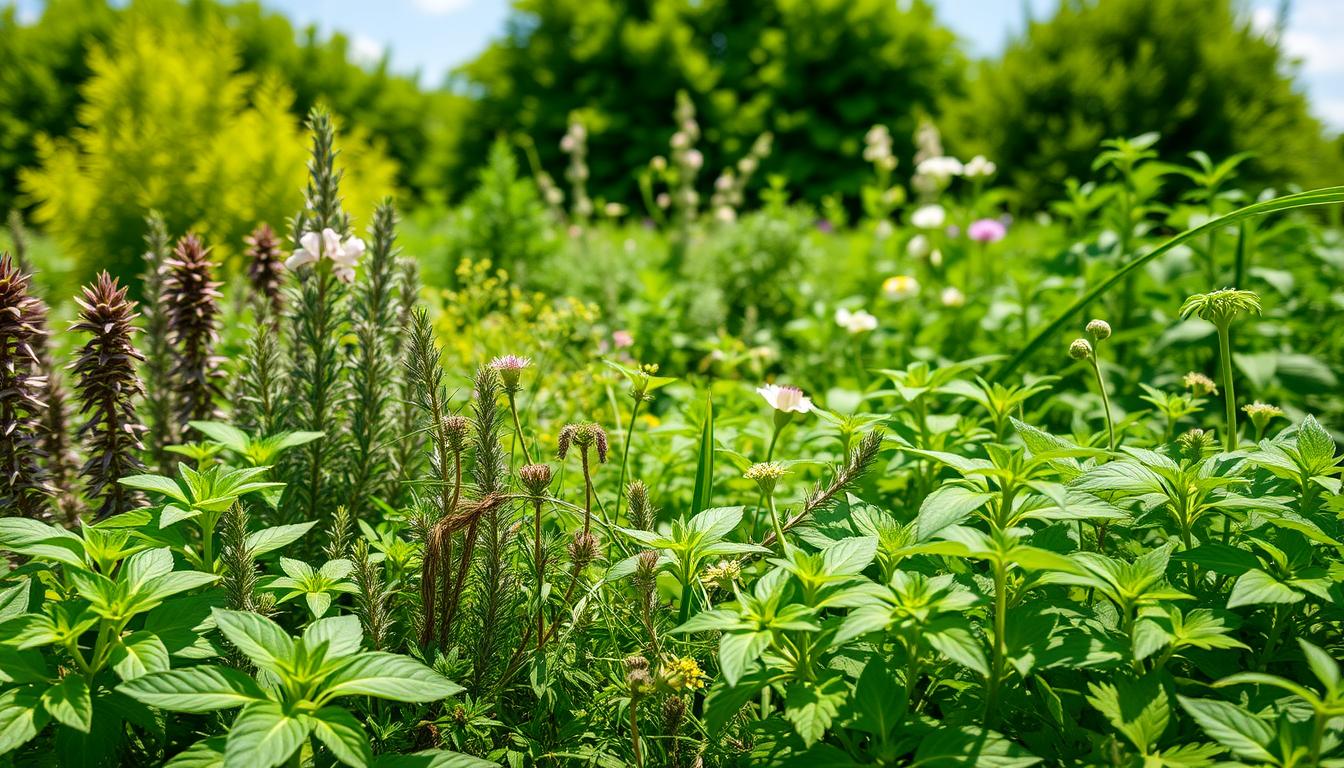
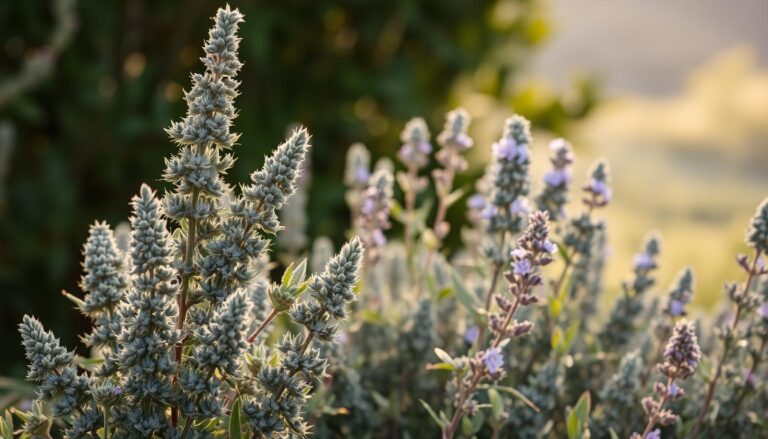

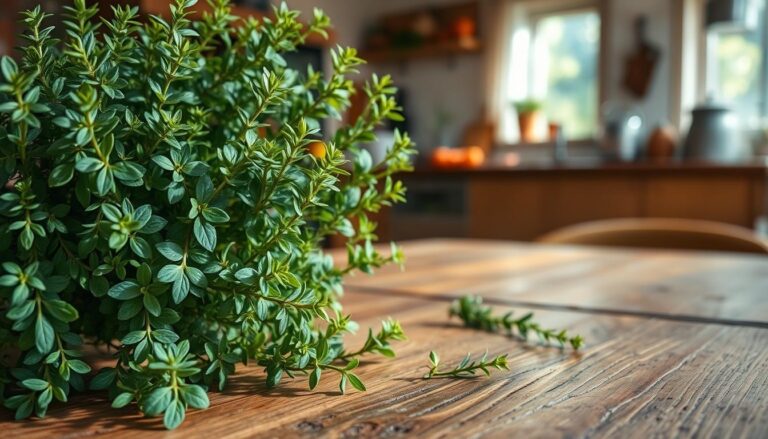
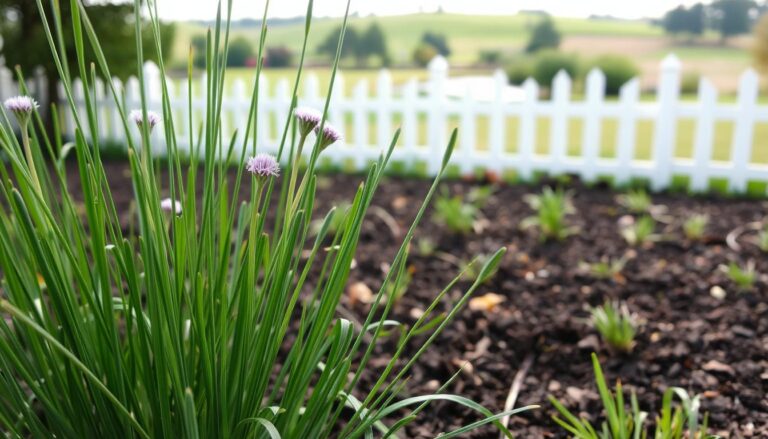
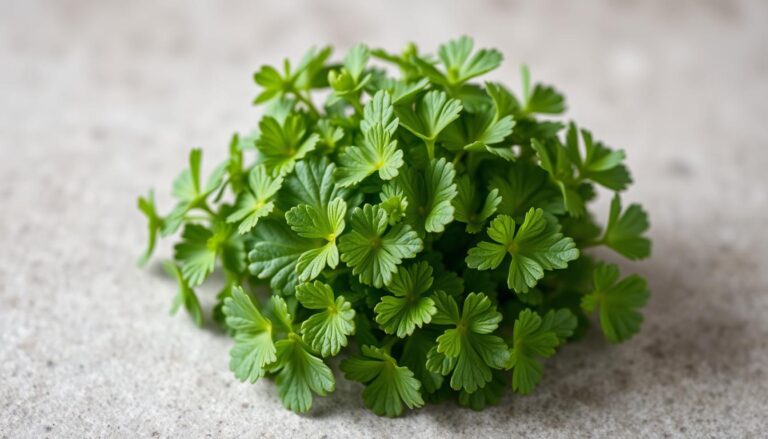

nice